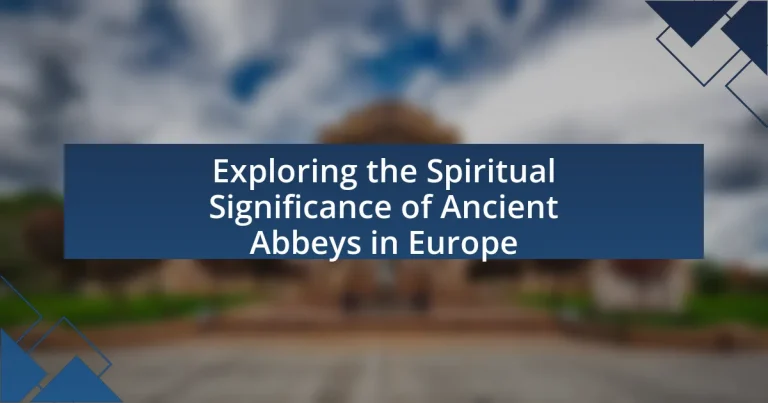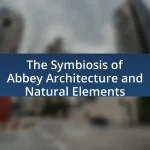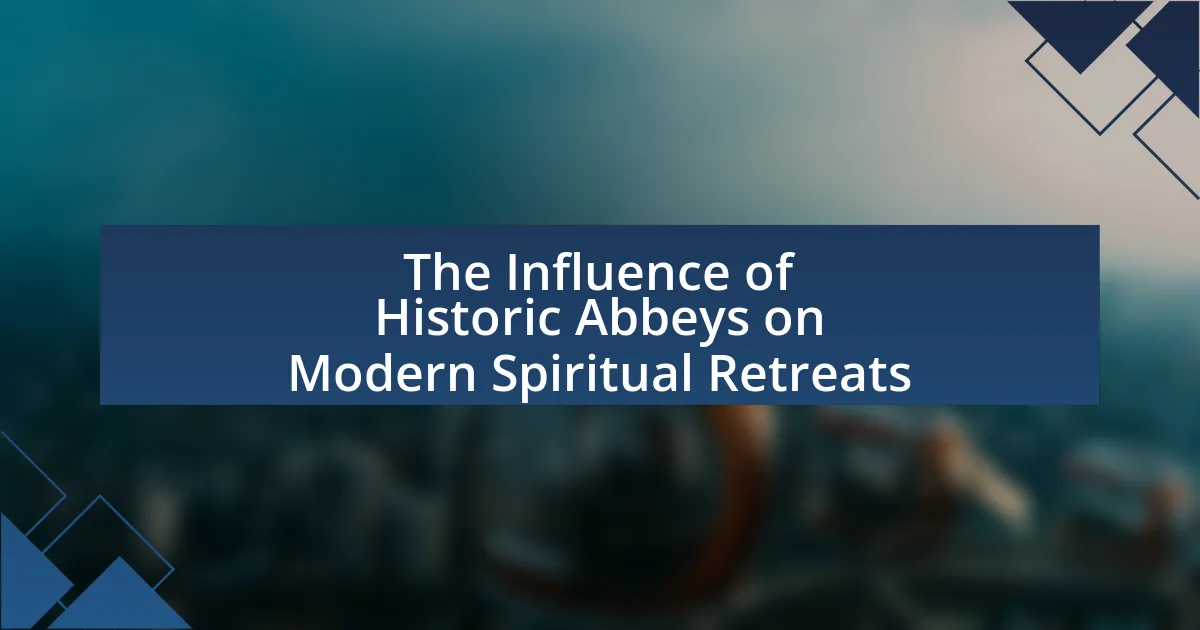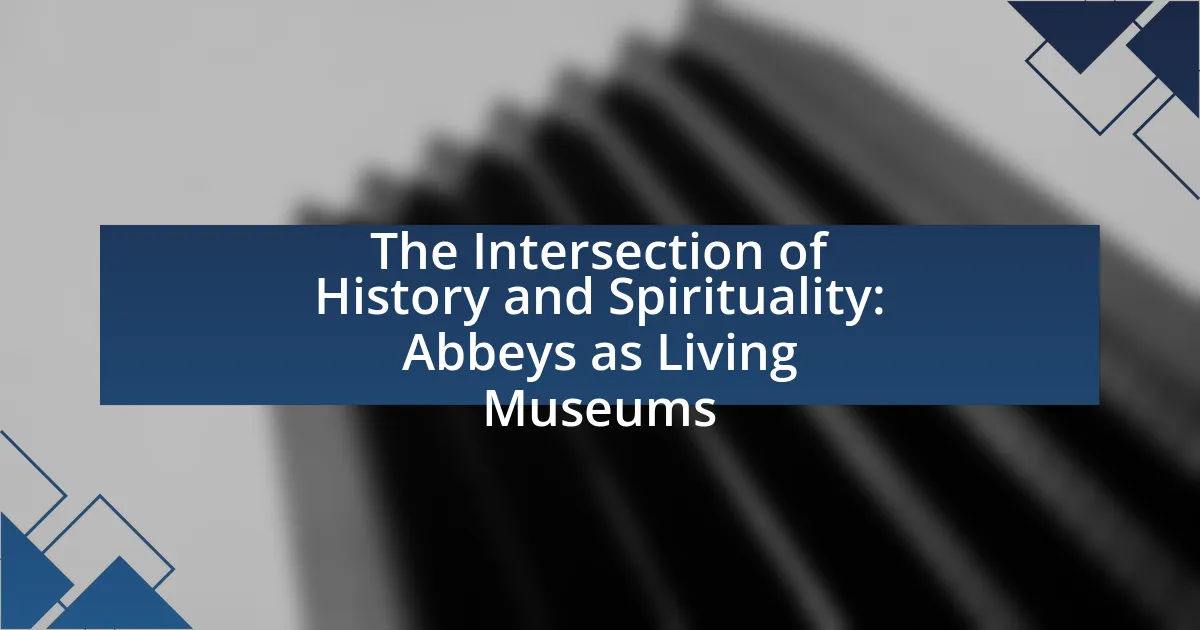Ancient abbeys are significant religious structures that served as monastic communities for Christian monks during the Middle Ages, playing a crucial role in the spiritual and cultural life of Europe. These abbeys originated from the monastic movement initiated by St. Benedict, emphasizing communal living and spiritual discipline, and became centers for education, agriculture, and hospitality. The article explores the historical context of abbeys, their architectural styles, including Romanesque and Gothic, and their spiritual significance as places of worship and pilgrimage. Additionally, it examines modern perspectives on abbeys, their preservation challenges, and how they continue to influence contemporary spirituality and personal growth.

What are Ancient Abbeys and Their Historical Context?
Ancient abbeys are religious buildings that served as monastic communities, primarily for Christian monks, during the Middle Ages. These structures were integral to the spiritual and cultural life of Europe, often established in remote locations to facilitate contemplation and devotion. Historically, abbeys functioned as centers of learning, agriculture, and hospitality, contributing significantly to the preservation of knowledge and the development of local economies. For instance, the Abbey of Cluny, founded in 910 in France, became a model for monastic reform and influenced the establishment of numerous other abbeys across Europe. The architectural styles of ancient abbeys, such as Romanesque and Gothic, reflect the artistic and spiritual aspirations of their time, further emphasizing their importance in the historical context of European spirituality.
How did ancient abbeys originate in Europe?
Ancient abbeys in Europe originated primarily from the monastic movement initiated by St. Benedict in the 6th century, which emphasized communal living and spiritual discipline. These abbeys were established as centers for religious life, education, and agricultural development, often located in remote areas to facilitate contemplation and devotion. The Rule of St. Benedict provided a structured framework for monastic life, leading to the proliferation of abbeys across Europe, particularly during the Carolingian Renaissance in the 8th and 9th centuries, when many were founded under the patronage of kings and nobles. Historical records indicate that by the 10th century, hundreds of abbeys had been established, significantly influencing the cultural and spiritual landscape of medieval Europe.
What role did monasticism play in the establishment of abbeys?
Monasticism was fundamental in the establishment of abbeys as it provided the organizational and spiritual framework necessary for their creation. Monastic communities, dedicated to a life of prayer, work, and communal living, often sought to create centers of worship and learning, leading to the founding of abbeys. Historical evidence shows that figures like St. Benedict, through the Rule of St. Benedict in the 6th century, set guidelines for monastic life that influenced the structure and function of abbeys across Europe. These abbeys became not only religious centers but also hubs of agriculture, education, and cultural preservation, significantly shaping medieval society.
How did the socio-political landscape influence the development of abbeys?
The socio-political landscape significantly influenced the development of abbeys by providing the necessary support and resources for their establishment and growth. During the early medieval period, the rise of feudalism created a need for religious institutions that could offer stability, education, and social services, leading to the construction of abbeys as centers of community life. Additionally, the patronage from local lords and monarchs often determined the location and wealth of these abbeys, as seen in the establishment of Cluny Abbey in the 10th century, which received substantial support from the Duke of Aquitaine. This relationship between abbeys and the socio-political elite facilitated the spread of monastic reforms and the establishment of influential religious orders, further embedding abbeys into the fabric of medieval society.
What architectural styles are commonly found in ancient abbeys?
Ancient abbeys commonly feature Romanesque and Gothic architectural styles. Romanesque architecture, prevalent from the 9th to the 12th centuries, is characterized by thick walls, rounded arches, and sturdy pillars, exemplified by structures like the Abbey of Cluny in France. Gothic architecture, emerging in the 12th century, is noted for its pointed arches, ribbed vaults, and flying buttresses, as seen in the Abbey of Saint-Denis, which influenced many later ecclesiastical buildings. These styles reflect the spiritual and functional needs of monastic life, emphasizing stability and verticality to inspire awe and devotion.
What are the key features of Romanesque architecture in abbeys?
The key features of Romanesque architecture in abbeys include thick walls, rounded arches, barrel vaults, and large towers. These structural elements were designed to support the heavy stone construction typical of the period, which spanned from the 9th to the 12th centuries. The use of thick walls provided stability and allowed for fewer windows, resulting in dimly lit interiors that enhanced the spiritual atmosphere. Rounded arches were not only aesthetically pleasing but also effective in distributing weight, while barrel vaults created expansive ceilings that contributed to the grandeur of the space. Additionally, large towers often served both functional and symbolic purposes, representing a connection to the divine. These architectural features collectively reflect the Romanesque style’s emphasis on solidity and spirituality, aligning with the monastic ideals of the time.
How does Gothic architecture manifest in abbey structures?
Gothic architecture manifests in abbey structures through features such as pointed arches, ribbed vaults, and flying buttresses. These elements not only enhance the aesthetic appeal but also serve structural purposes, allowing for taller and more light-filled interiors. For instance, the use of pointed arches enables the distribution of weight more efficiently, which is evident in the design of the Abbey of Saint-Denis, a pioneering example of Gothic architecture completed in the 12th century. Additionally, the incorporation of large stained glass windows in abbeys, such as those found in Chartres Cathedral, creates an ethereal atmosphere that reflects the spiritual aspirations of the time, allowing natural light to illuminate the sacred spaces.
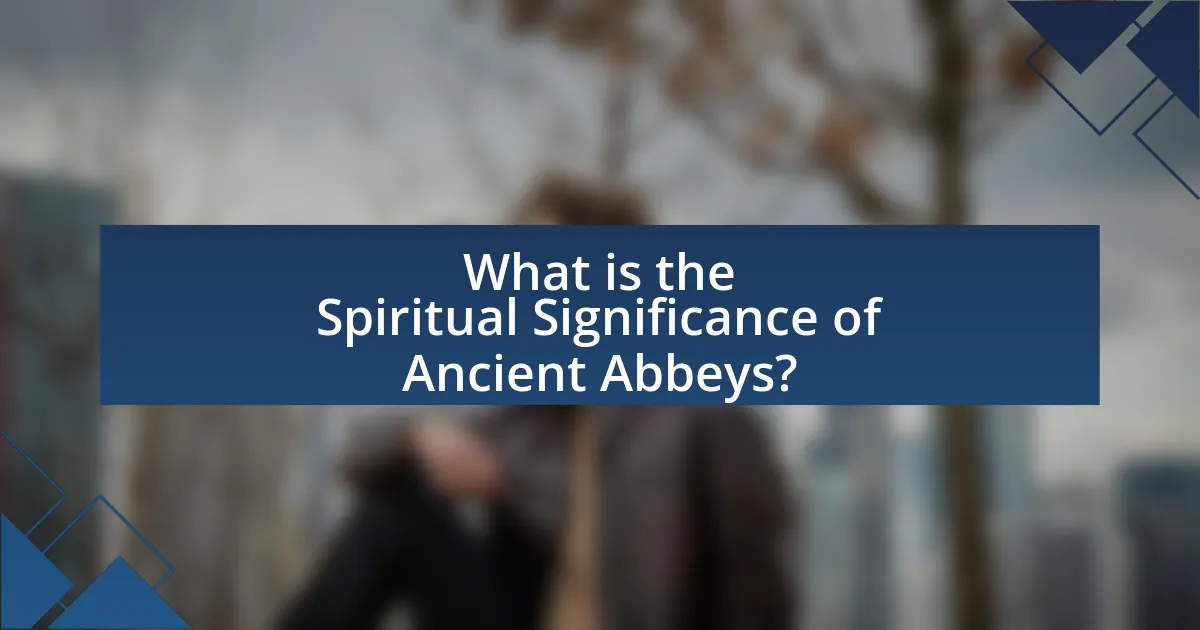
What is the Spiritual Significance of Ancient Abbeys?
Ancient abbeys hold significant spiritual importance as centers of monastic life, prayer, and community worship. These structures were often built in remote locations to facilitate contemplation and connection with the divine, embodying the ideals of asceticism and devotion central to various religious traditions, particularly Christianity. Historically, abbeys served as places where monks and nuns dedicated their lives to spiritual practices, education, and the preservation of religious texts, contributing to the cultural and spiritual heritage of Europe. For instance, the Abbey of Cluny, founded in 910, became a model for monastic reform and emphasized the importance of liturgical worship, influencing countless other abbeys across the continent.
How do ancient abbeys serve as centers of spirituality?
Ancient abbeys serve as centers of spirituality by providing a dedicated space for worship, contemplation, and community life. These structures often house monastic communities that engage in prayer, meditation, and the study of religious texts, fostering a deep spiritual atmosphere. Historical evidence shows that abbeys, such as Mont Saint-Michel in France and Westminster Abbey in England, have been pivotal in shaping religious practices and beliefs in their regions, attracting pilgrims and visitors seeking spiritual enrichment. The architectural design of abbeys, with their serene environments and sacred art, further enhances their role as spiritual sanctuaries, facilitating a connection between the divine and the individual.
What practices and rituals are associated with abbey life?
Abbey life is characterized by practices and rituals such as communal prayer, the Liturgy of the Hours, and monastic work. Communal prayer occurs multiple times a day, fostering a sense of unity among the monks or nuns. The Liturgy of the Hours, also known as the Divine Office, involves specific prayers and psalms recited at designated times, reflecting the rhythm of the day and the seasons. Monastic work, or “ora et labora” (pray and work), emphasizes the importance of labor in various forms, including agriculture, craftsmanship, and hospitality, which supports the community and its spiritual mission. These practices are rooted in the Rule of St. Benedict, established in the 6th century, which outlines the daily life and spiritual discipline of monastic communities.
How do abbeys contribute to personal spiritual journeys?
Abbeys contribute to personal spiritual journeys by providing a serene environment conducive to reflection, meditation, and prayer. These religious communities often emphasize a lifestyle of simplicity and devotion, which can inspire individuals to deepen their spiritual practices. Historical records indicate that abbeys have served as centers of spiritual learning and guidance for centuries, attracting seekers who wish to explore their faith in a tranquil setting. For example, the Rule of St. Benedict, which many abbeys follow, promotes a balanced life of work, prayer, and community, fostering personal growth and spiritual development.
Why are ancient abbeys considered pilgrimage sites?
Ancient abbeys are considered pilgrimage sites primarily due to their historical association with religious significance and the veneration of saints. Many abbeys were built to house relics of saints, which attracted pilgrims seeking spiritual healing, guidance, or a deeper connection to their faith. For example, the Abbey of Saint Gall in Switzerland became a major pilgrimage destination because it housed the relics of Saint Gall, drawing thousands of visitors throughout the centuries. Additionally, the architectural grandeur and serene environments of these abbeys often served as places for reflection and spiritual renewal, further solidifying their status as pilgrimage sites in the Christian tradition.
What historical events have made certain abbeys popular pilgrimage destinations?
Certain historical events have made specific abbeys popular pilgrimage destinations, notably the canonization of saints, miraculous occurrences, and significant religious relics. For example, the Abbey of Saint-Germain-des-Prés in Paris became a pilgrimage site after the relics of Saint Germain were venerated, attracting numerous pilgrims seeking healing and spiritual solace. Similarly, the Abbey of Mont-Saint-Michel gained prominence due to the reported visions of Saint Aubert, which led to its construction and subsequent recognition as a site of miraculous events. The presence of relics, such as those at the Abbey of Cluny, further solidified its status as a pilgrimage destination, as believers sought to connect with the divine through these sacred objects. These events not only enhanced the spiritual significance of these abbeys but also contributed to their enduring popularity among pilgrims throughout history.
How do the relics and artifacts within abbeys enhance their spiritual significance?
Relics and artifacts within abbeys enhance their spiritual significance by serving as tangible connections to the divine and the history of faith. These items, often believed to possess miraculous powers or to be associated with saints, create a sacred atmosphere that fosters devotion and reflection among visitors. For instance, the presence of relics, such as bones or belongings of saints, is thought to facilitate intercession and blessings, thereby deepening the spiritual experience of worshippers. Historical records indicate that abbeys housing significant relics, like the Abbey of Saint-Denis in France, attracted pilgrims seeking spiritual healing and enlightenment, illustrating the profound impact these artifacts have on the spiritual landscape.

What Modern Perspectives Exist on Ancient Abbeys?
Modern perspectives on ancient abbeys emphasize their roles as cultural heritage sites, centers for spiritual reflection, and venues for community engagement. Scholars and historians recognize that these structures not only represent architectural achievements but also embody the historical narratives of monastic life and spirituality in Europe. For instance, the preservation efforts of abbeys, such as Mont Saint-Michel in France, highlight their significance in contemporary tourism and education, attracting millions of visitors annually who seek to understand their historical and spiritual contexts. Additionally, modern spiritual movements often draw inspiration from the contemplative practices historically associated with abbeys, reflecting a renewed interest in monastic traditions and their relevance in today’s fast-paced society.
How are ancient abbeys preserved and maintained today?
Ancient abbeys are preserved and maintained today through a combination of restoration efforts, conservation practices, and community involvement. Restoration projects often involve skilled artisans who use traditional techniques to repair and restore architectural features, ensuring historical accuracy. Conservation practices include regular maintenance to prevent deterioration, such as controlling moisture levels and protecting against pests. Additionally, many abbeys benefit from the support of local communities and heritage organizations that raise funds and promote awareness about their historical and cultural significance. For instance, the Abbey of Mont Saint-Michel in France has undergone extensive restoration since the 19th century, funded by both government and private donations, highlighting the collaborative effort in preserving these important historical sites.
What challenges do conservationists face in preserving abbey structures?
Conservationists face significant challenges in preserving abbey structures, primarily due to environmental degradation, funding limitations, and structural deterioration. Environmental factors such as moisture, pollution, and climate change can accelerate the decay of materials used in these historic buildings, leading to costly repairs. Funding limitations often hinder conservation efforts, as many abbeys rely on grants and donations, which can be inconsistent. Additionally, structural deterioration, including issues like crumbling stonework and weakened foundations, poses ongoing risks to the integrity of these sites. For instance, a study by the Historic Environment Scotland in 2020 highlighted that over 60% of historic buildings, including abbeys, are at risk due to these factors, underscoring the urgency of effective conservation strategies.
How do modern visitors engage with the spiritual aspects of abbeys?
Modern visitors engage with the spiritual aspects of abbeys through immersive experiences that include guided tours, meditation sessions, and participation in religious services. These activities allow visitors to connect with the historical and spiritual significance of the abbeys, often rooted in centuries of monastic tradition. For example, many abbeys offer opportunities for silent retreats, where individuals can reflect and meditate in serene environments, enhancing their spiritual experience. Additionally, the architecture and art within abbeys, such as stained glass windows and altarpieces, serve as focal points for contemplation, further deepening visitors’ engagement with the spiritual heritage of these sites.
What role do ancient abbeys play in contemporary spirituality?
Ancient abbeys serve as significant centers for contemporary spirituality by providing spaces for reflection, meditation, and community engagement. These historical sites often embody a rich spiritual heritage, attracting individuals seeking solace and connection to the past. For example, many abbeys host retreats and workshops that focus on mindfulness and spiritual growth, allowing participants to immerse themselves in a tranquil environment that fosters inner peace. Additionally, the architectural beauty and serene landscapes surrounding these abbeys enhance the spiritual experience, making them popular destinations for those exploring their faith or seeking a deeper understanding of spirituality.
How can individuals incorporate lessons from abbey spirituality into their lives?
Individuals can incorporate lessons from abbey spirituality into their lives by practicing mindfulness, community engagement, and a commitment to simplicity. Mindfulness can be cultivated through regular meditation and reflection, which are central to abbey life, allowing individuals to connect deeply with their inner selves and the present moment. Community engagement mirrors the communal living found in abbeys, encouraging individuals to foster relationships and support networks, thus enhancing social bonds and shared values. A commitment to simplicity can be achieved by decluttering one’s life, focusing on essential needs, and embracing a lifestyle that prioritizes spiritual over material wealth, reflecting the austere living conditions often found in abbeys. These practices not only promote personal growth but also align with the core principles of abbey spirituality, which emphasize harmony, balance, and a deeper connection to the divine.
What are some examples of modern spiritual retreats held in abbeys?
Some examples of modern spiritual retreats held in abbeys include the Abbey of Gethsemani in Kentucky, which offers silent retreats focused on contemplation and prayer, and the Benedictine Abbey of St. Walburga in Colorado, known for its programs on mindfulness and spiritual growth. Additionally, the Abbey of Our Lady of Gethsemani in Trappist, Kentucky, hosts retreats that emphasize monastic practices and spiritual renewal. These retreats are designed to provide participants with an immersive experience in a tranquil, sacred environment, fostering deep spiritual reflection and connection.
What practical tips can enhance a visit to an ancient abbey?
To enhance a visit to an ancient abbey, plan your visit during off-peak hours to avoid crowds, allowing for a more contemplative experience. Visiting early in the morning or late in the afternoon often provides a quieter atmosphere, which is conducive to reflection and appreciation of the abbey’s architecture and history. Additionally, consider joining a guided tour, as knowledgeable guides can provide insights into the abbey’s historical significance, architectural details, and spiritual context, enriching your understanding of the site. Engaging with the abbey’s surroundings, such as gardens or walking paths, can also deepen your connection to the spiritual ambiance. Lastly, check for any special events or services, as participating in these can offer a unique perspective on the living traditions associated with the abbey.
